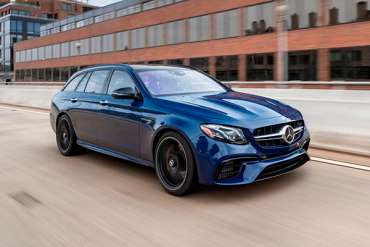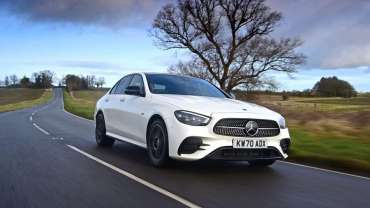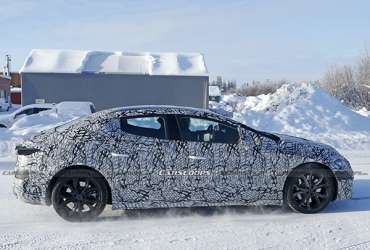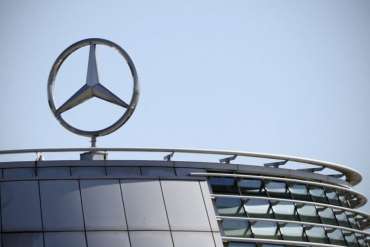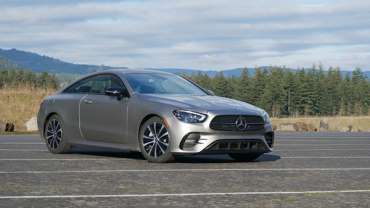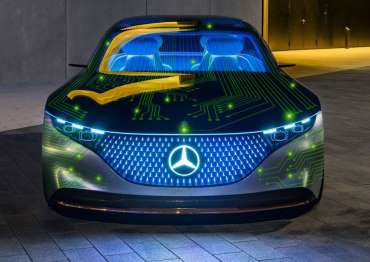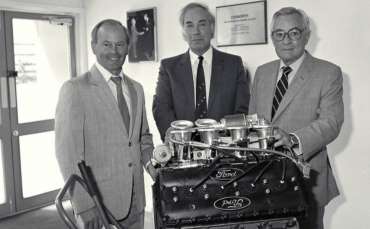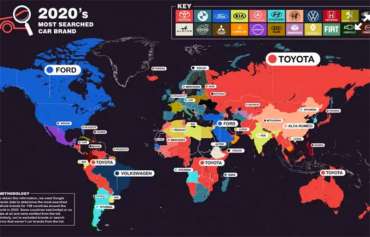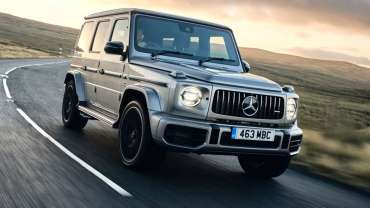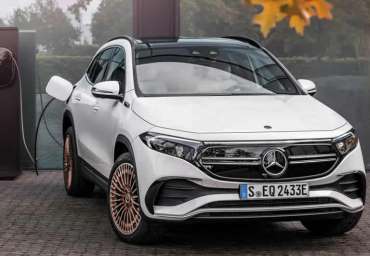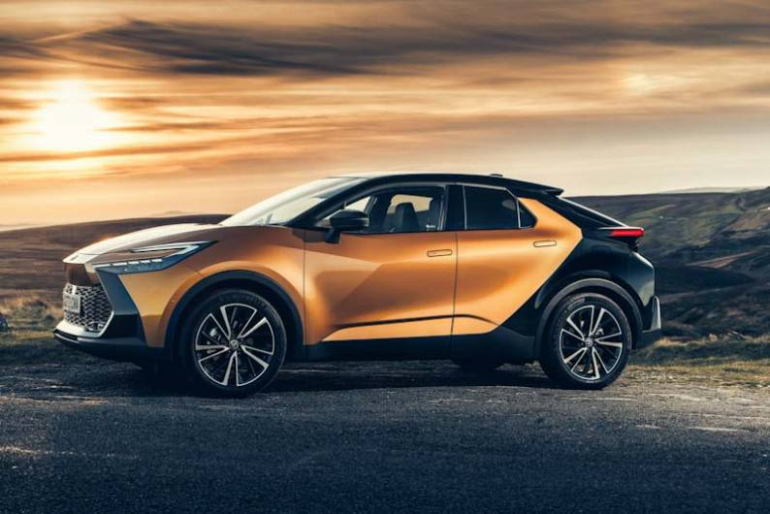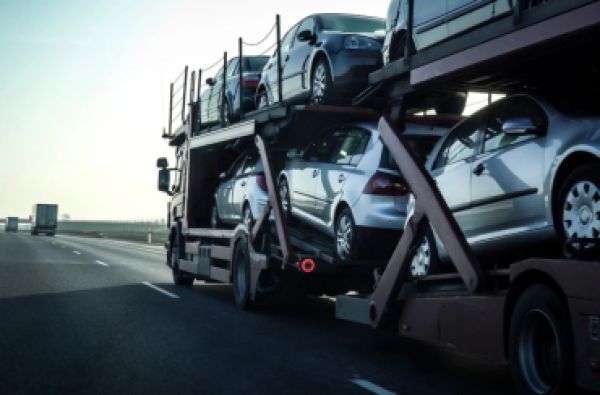Displaying items by tag: Mercedes
2021 Mercedes-AMG E 63 S Wagon Unparalleled Exclusivity
Mercedes-Benz does not break down its end-of-year sales by model, but we know that the 2021 Mercedes-AMG E63 Wagon is a rare car; it’s likely more exclusive than most Ferrari and Lamborghini models. “Generically speaking [E63 S Wagon owners] are high income and are very much brand and model-loyal,” a Mercedes spokesperson told CarBuzz. “[They] do not differ so much from a typical AMG customer; rather, the E63 S Wagon buyer is more of a superlative of these characteristics.”
Seeing an E63 S Wagon on the road is already rare sight, especially in the wagon-phobic US market, but Mercedes gives its customers a chance to be even more unique. Mercedes offers the Designo Manufaktur program, which allows owners to “have a car painted in a historic Mercedes-Benz color, painted to match a color sample.” Think of it like Porsche’s Paint to Sample Program but less saturated on social media.

“Nearly any color is possible through this program, from various shades of purple to bright greens and yellows,” Mercedes told us. More often than not, these colors are a one-of-one, making them highly coveted on the second-hand market. “Only a few dozen E63 S Wagons go through this special process each year,” including the pre-facelift 2020 E63 S Wagon pictured here wearing a Designo Manufaktur Steel Blue exterior paint with an AMG Black Exclusive Nappa leather interior.
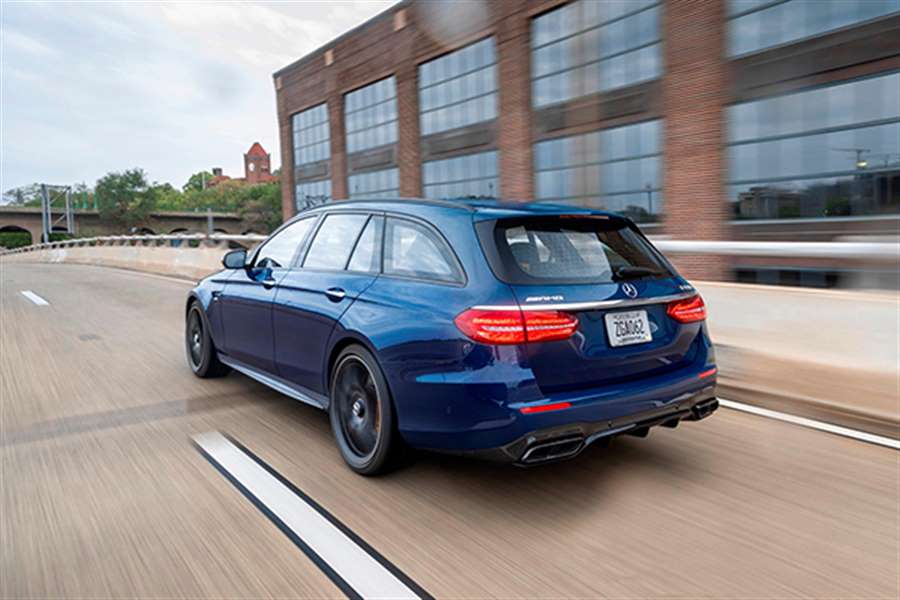
Audi offers something similar through its Audi Exclusive program, which allows owners to order virtually any color on their RS6 Avant. But unlike Mercedes, which only sells a handful of custom-painted wagons per year, Audi’s program is completely booked for 2021.
“At AMG, I think it’s fair to say that we not only appreciate strong competition, but we seek it out,” Mercedes commented about the recent wagon rival from Audi. “We compete in race series around the world (F1, IMSA, DTM, etc.), but we also compete in numerous competitive segments in the US market and others. Competition is good for the industry as a whole and helps to bolster the wagon segment, for which we set the benchmark.”
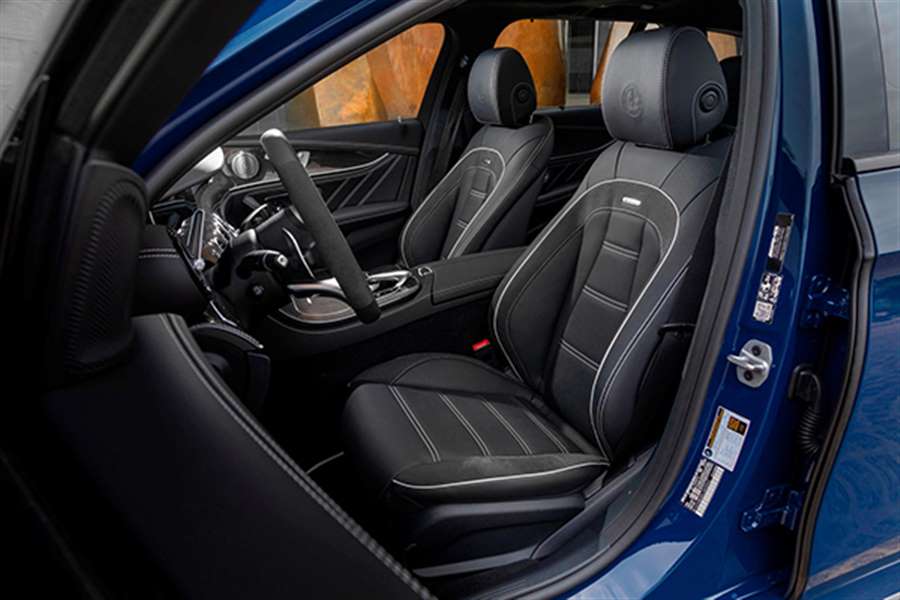
There’s no arguing that the introduction of the RS6 Avant to the North American market hasn’t gone unnoticed by enthusiasts, but the E63 S is heavily facelifted for the 2021 model year to take on the competition.
“The overall goal was to make the E63 better in a number of measurable ways. By bringing over knowledge we gained in the development of other products (i.e., the AMG GT 4-door).”
The most notable difference between the 2020 E63 and the facelifted 2021 model, aside from the styling (pictured above), is the suspension. “We revised some of our bushing stiffness and adjustable suspension logic in an effort to make the car both more comfortable for around-town driving, and more sporty on a back road or a racetrack. The tuning has been affected by changing the bushing stiffness and changing the logic for the air springs and variable dampers.”
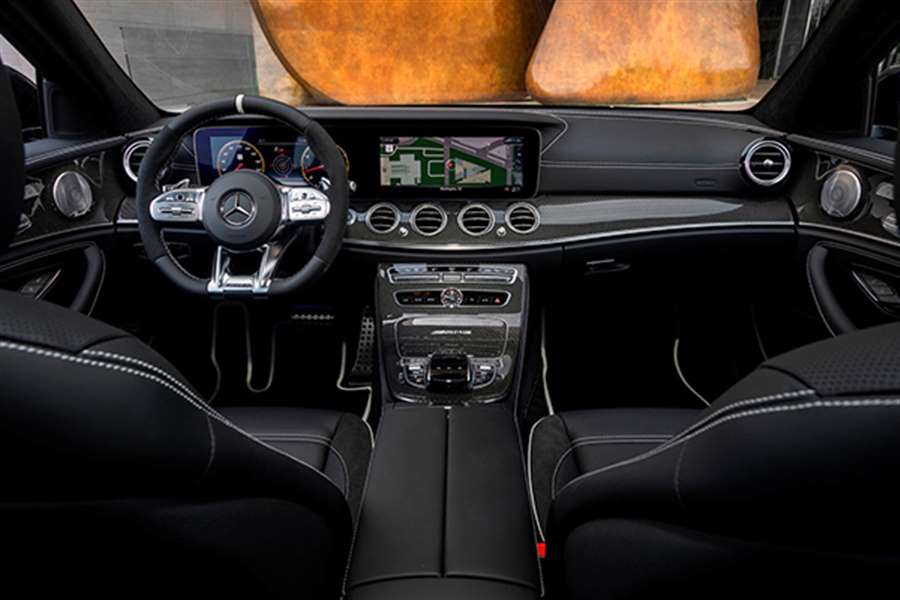
We’ll have to evaluate the effectiveness of AMG’s suspension changes in our upcoming E63 Wagon review. Audi typically places a heavy emphasis on comfort, even on the RS models, so it might be tough for AMG to challenge in this area.
Mercedes E-Class hybrid review
"The smooth and quick Mercedes E-Class plug-in hybrids combine luxury with impressive fuel efficiency”
Those who live out of town might only encounter heavy traffic during the latter stages of the daily commute to and from work. It's in these circumstances, where the roads get congested, slow and polluted, that a plug-in hybrid really makes sense, and the Mercedes E 300 e and E 300 de plug-in hybrid’s are compelling options for those who want a decent amount of pure-electric range and low running costs for the daily commute.
The E-Class hybrid range underwent a midlife facelift in 2020, getting a subtly tweaked exterior design that included a new grille and restyled LED headlights. The interior was also given a tech refresh with the latest touchscreen version of Mercedes’ MBUX infotainment system.
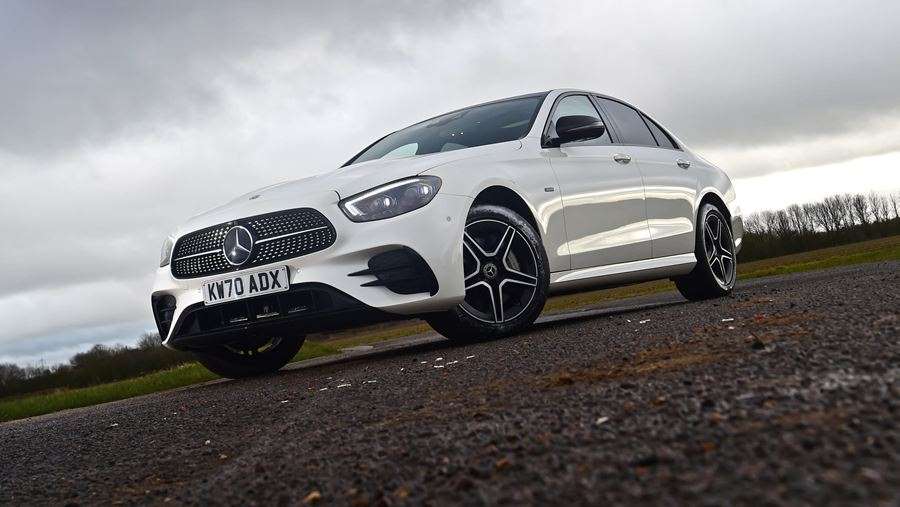
Unlike plug-in hybrid rivals such as the BMW 530e and Volvo S90 T8 Recharge, which can only be had with a petrol engine and electric motor, the E-Class hybrid is available as a petrol or a diesel, badged ‘E 300 e’ and ‘E 300 de’ respectively.
Both versions combine their conventional internal combustion engines with a compact battery and an electric motor that's capable of propelling the car using only pure-electric power, while emitting zero CO2 emissions. Mercedes claims both cars are capable of triple-digit fuel economy figures, low CO2 emissions and over 30 miles of pure-electric range.
In fact, make frequent use of that capability and you could come close to realising Mercedes' fuel-efficiency claims, while emitting less than 50g/km of CO2 – a figure far lower than a petrol or diesel car can deliver. The former is good news for anyone who has to pay for fuel and the latter will be appreciated by company-car drivers who have the cost of Benefit-in-Kind (BiK) tax to worry about.
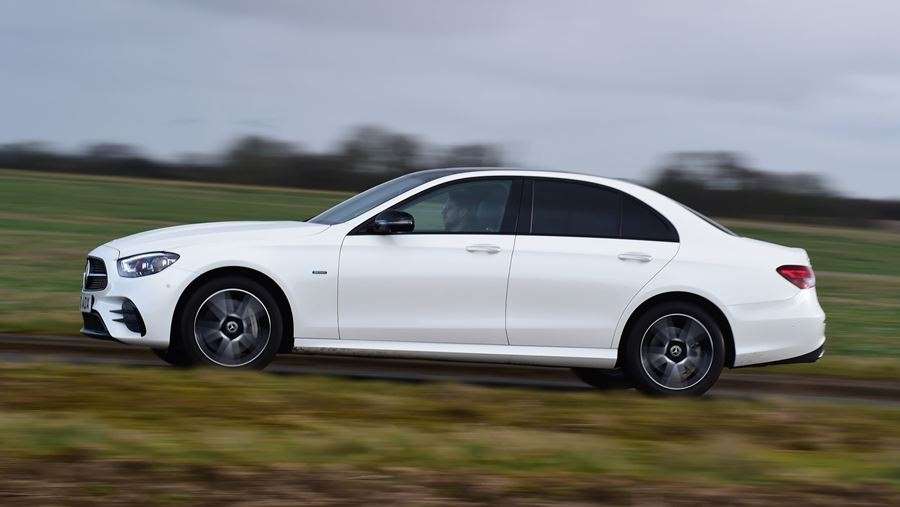
Away from what's under the bonnet, the cars conform to the usual E-Class template. That is to say you get an elegant, upmarket-looking car that continues to impress when you take a seat inside, finding yourself surrounded by high-quality materials, attractive finishes and advanced technology. A highlight of the latter is the dual-screen digital dashboard and infotainment system, as well as the smart blue mood lighting unique to the plug-in hybrid.
Every Mercedes E-Class is a smooth, quiet cruiser and the E 300 e and de are no exception. Although the four-cylinder petrol and diesel engines aren't as pleasing to the ear as a six-cylinder might be, it's certainly not obstructive and settles into the background once up to cruising speed. The ride is smooth and wind noise is minimal, so motorway cruising is relaxed.
The E-Class doesn't embarrass itself on winding roads, either – it doesn't have quite the steering precision of a BMW 5 Series or feel quite as agile when you pitch it into a fast corner, nor does it resist body lean as stoically as an Audi A6, but it's responsive, safe and well controlled, so you can take the rural route home in a hurry if you want to. There's no shortage of power, either – the E 300 e petrol engine produces 208bhp and the 121bhp electric motor provides a handy boost, for a total of 316bhp when you need it. Acceleration from 0-62mph takes less than six seconds.
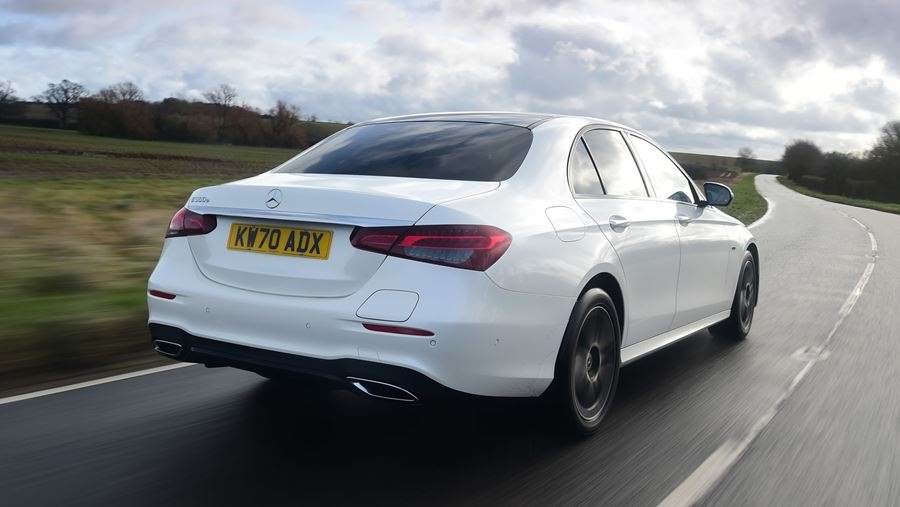
The E 300 de diesel version is no slouch either, taking 5.9 seconds, and might be better suited to those who make frequent long high-speed journeys with an urban portion at either end.
Overall, the E-Class is a fantastic executive saloon that makes plenty of sense for business drivers. Its range and technology impress, as does refinement and the interior, but we'd stick with the AMG Line Edition without adding expensive Premium packs for the best value.
MPG, running costs & CO2
Business drivers stand the best chance of saving money in a Mercedes E 300 e or de
If your daily commute runs to no more than 15 miles each way, both the petrol and diesel versions of the Mercedes E-Class plug-in hybrid can get you to work and back without having to burn any fuel at all. This is courtesy of a claimed all-electric range of over 30 miles, which also helps the E 300 e to return a claimed fuel-economy figure of 176.6mpg, with the E 300 de even more efficient at up to 235.4mpg. The digital dashboard gives suggestions for economical driving, which can actually be curiously engaging to follow, gamifying the driving experience.
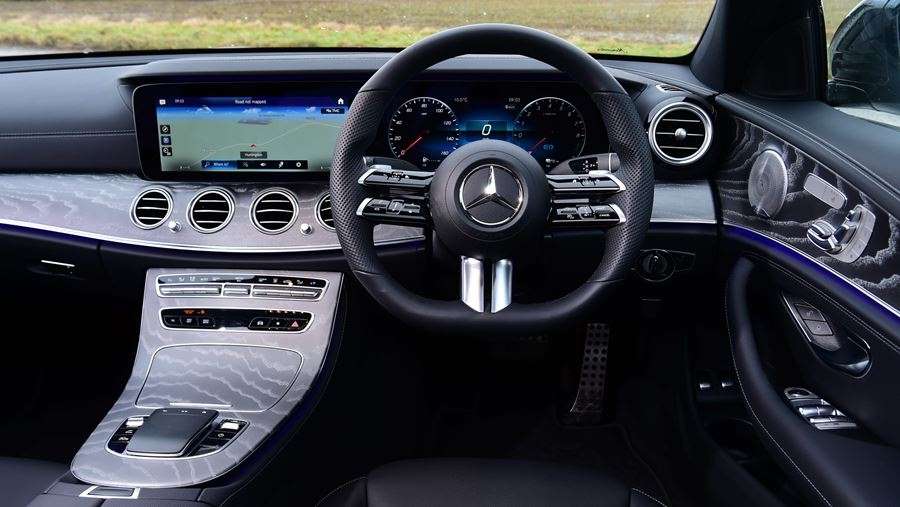
However, the testing procedure under which these economy figures were achieved assumes that owners can maximise the use of electric mode for a majority of their driving. If you cannot recharge the battery, or are making longer journeys where the battery becomes depleted, then you will be relying on the engine more often, which will make the official fuel consumption figures impossible to achieve.
During our test of the E 300 e, we spent the majority of our time running in pure-electric mode. One of the most impressive aspects of the car is its realistic electric range estimate, with a mile of range falling for every actual mile travelled - sadly this isn’t the case in every electrified car.
While Mercedes claims 33-35 miles of range with a fully charged battery, most drivers should be able to manage close to 20-25 miles in mixed driving, with around 30 miles possible at slower speeds in town. With the battery depleted, fuel economy is liable to fall to around 35mpg.
When compared to the petrol version, the E 300 de is a slightly different prospect that’s aimed at higher mileage drivers. While the claimed fuel economy of over 200mpg is a little fanciful, regular charging of the battery and careful use of the car’s driving modes returns around 51mpg across a mix of town and motorway driving. When running on pure-electric power, we were able to eke out around 15-20 miles, which is somewhat short of the 32-34 miles claimed by Mercedes. Once the battery was depleted, fuel economy fell to around 43mpg.
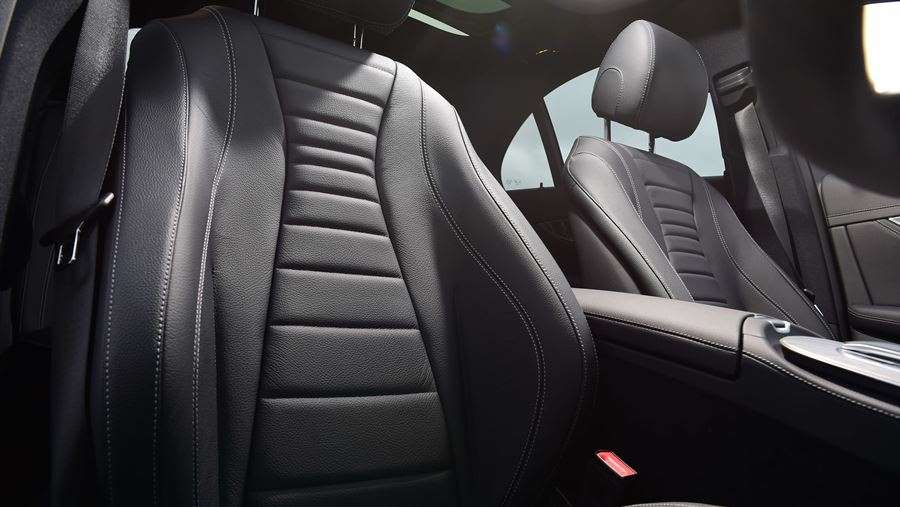
Every E-Class hybrid offers different driving modes to either hold onto battery charge (until you reach a town for instance), stay in electric mode, or use a mixture of engine and electric power. All aim to help the driver to maximise fuel economy.
The official CO2 emission figures of both cars are cast in stone regardless of your driving habits, with the E 300 e emitting 37g/km and the E 300 de just 33g/km. This means that company-car users can enjoy a low Benefit-in-Kind (BiK) rating, which is far lower than any pure petrol or diesel version of the E-Class; the likes of the E 200 and E 220 d sit close to the top of the BiK ratings.
The 13.5kWh battery can be charged via 7.2kWh wallbox in 1.5 hours. Opt for a three-pin plug socket and you can expect to wait around five hours for charging to complete. Unlike fully electric cars, there’s no fast-charging option.
Other running costs are unlikely to differ from the Mercedes E-Class norm, which is to say expensive servicing but reasonable parts prices and tyres that are a fairly common, sensibly priced size. You can take out a service contract to help manage the cost of routine servicing, and there's a three-year/unlimited-mileage warranty, which can be extended at extra cost.
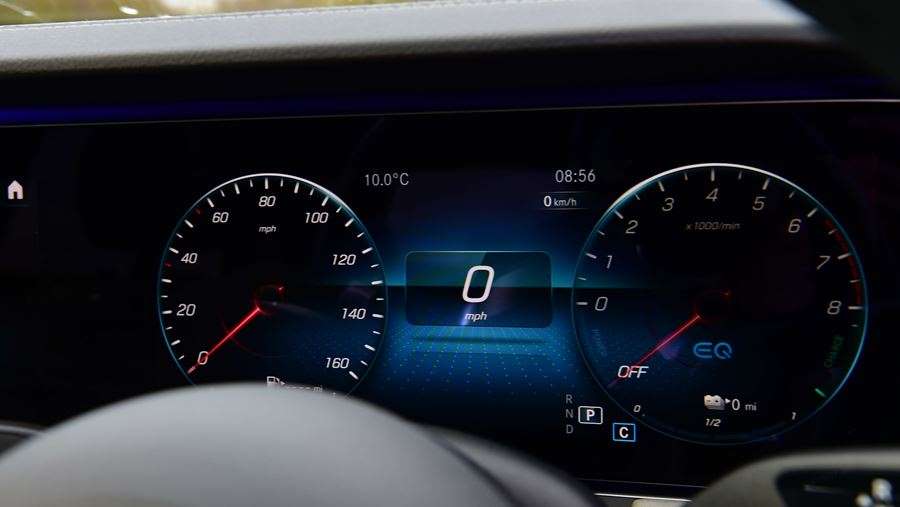
The E-Class hybrid costs more than £40,000 to buy, incurring an additional tax surcharge of £325 a year. After this period, tax falls to the typical reduced rate for hybrids.
Engines, drive & performance
Plug-in hybrid power serves up strong performance, but doesn't bring excitement
The Mercedes E 300 e plug-in hybrid is very similar in concept to its BMW 530e hybrid rival. Both cars use a 2.0-litre turbocharged petrol engine, a battery pack and an electric motor. The Mercedes is faster, though.
With 208bhp from the petrol engine alone, 121bhp available from the electric motor and a total of 316bhp to call upon when you need it, the E 300 e can sprint from 0-62mph in 5.7 – and sprint is the operative word, with the electric motor capable of delivering all its power instantly. This makes it feel surprisingly urgent when you nudge the throttle, despite its size and weight.
However, the four-cylinder petrol engine can sound somewhat strained if you floor the throttle, with a noise that isn't as smooth or pleasing to the ear as the V6 in the Mercedes-AMG E 53; it just emits a nondescript wall of sound under full acceleration. This fades away when you take it easy, though, and is quieter than the E 220 d's diesel engine when cruising on the motorway. It's a shame, though, that such exciting acceleration doesn't come with an equally appealing soundtrack, and that the petrol engine has to work that much harder once the battery is depleted.
The E 300 e doesn't offer the last word in driving pleasure on a twisty road, either. Instead, the E-Class focuses on comfort and refinement over outright handling prowess. It feels planted and secure in corners but falls short for driver involvement when compared to a BMW 5 Series or Audi A6, even if its steering has a nicer feel.
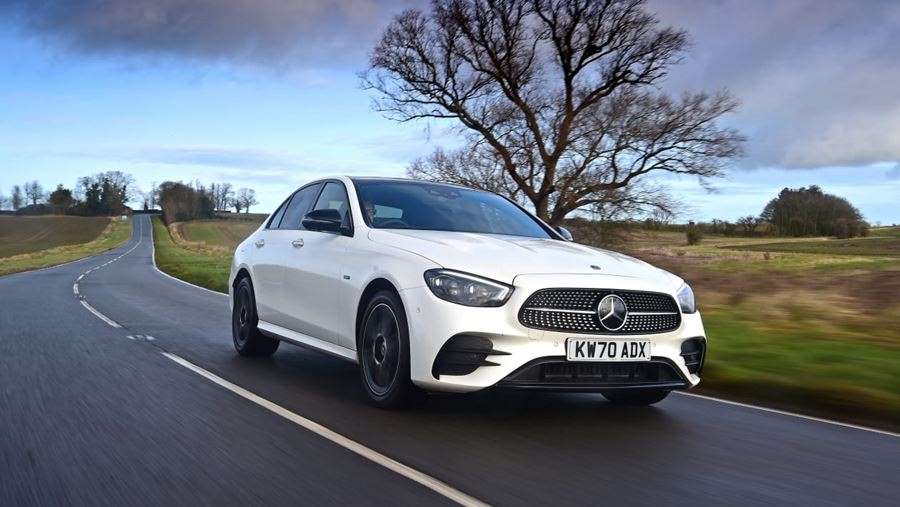
In terms of overall refinement, the E-Class excels against its rivals and the E 300 e is no exception. It absorbs bumps and potholes with ease, especially if you add the optional air suspension. There's barely any wind noise at motorway speeds, and engine noise only becomes noticeable when overtaking or joining fast-flowing traffic.
During normal driving, the switch between petrol and electric power is barely noticeable, but is perhaps not as smooth as it could be. Once in all-electric mode at lower speeds, there's barely any noise at all, aside from a faint hint of tyre roar and the whirr of the electric motor.
With a combined 302bhp and 700Nm of torque, the diesel powered E 300 de feels as quick as its petrol power sibling, with the benchmark 0-62mph time taking 5.9 seconds. In real-world driving, it offers more shove than the E300 e thanks to the increased pulling power from the 2.0-litre diesel engine.
Switching between electric and diesel power is fairly unobtrusive, with a distant thrum letting you know the engine has started. On occasions in electric mode, the car did hesitate slightly under hard acceleration as it decided whether to fire up the diesel engine.
Much like the petrol-powered version, the E 300 de is smooth and refined on the move, with only the occasional hint of diesel clatter making its way inside the car. The additional pulling power of the diesel engine means there’s always enough power in reserve for getting up to speed or overtaking.
Again, the E 300 de cannot match the dynamics of a diesel 5 Series, but offers a greater level of refinement. It feels planted though, with plenty of grip and accurate turn in. In sharper corners, the additional weight of the diesel engine is noticeable, but the handling is good enough for most drivers.
Interior & comfort
The Mercedes E 300 e has a hi-tech look inside, without feeling cold or unwelcoming
The ability to cruise so quietly on the motorway makes it easier to enjoy the E-Class hybrid’s comfortable and well-designed interior. Both the petrol E 300 e and diesel E 300 de are identical inside, and while the Audi A6 may offer a more futuristic look and improved material quality, many will prefer the more traditional, comfortable feel of the Mercedes.
In terms of overall refinement, the E-Class excels against its rivals and the E 300 e is no exception. It absorbs bumps and potholes with ease, especially if you add the optional air suspension. There's barely any wind noise at motorway speeds, and engine noise only becomes noticeable when overtaking or joining fast-flowing traffic.
Dashboard
The specification of the E-Class plug-in hybrid range is the same as the standard car, with every version getting a pair of 12.3-inch displays mounted in parallel to create the illusion of a seamless display that flows from in front of the driver to the centre console. It incorporates a fully configurable digital instrument cluster that can display a rev counter or an 'efficiency' gauge that can help you eke the most range from the car’s battery.
The left-hand panel hosts the touchscreen infotainment display, which incorporates sat nav with 3D mapping, Bluetooth smartphone connection, DAB radio, and access to Mercedes' online services. These include a concierge service that can provide real-time information about parking spaces and local petrol prices.
As part of the 2020 facelift, the infotainment system has been improved and is easier to navigate. The addition of a responsive touchscreen makes it easier to operate with Mercedes’ MBUX infotainment system, which is on par with the best in the class. Top versions even feature augmented reality sat nav, which overlays directions on a live video view of the road ahead. Apple CarPlay and Android Auto are both included, and are far more straightforward to use via the touch interface. The addition of the full-screen digital dials is a nice touch as well, adding a luxury element from the S-Class.
The facelifted E-Class boasts an all-new steering wheel, which features a number of physical buttons. This layout is slightly confusing at first but is easy to get used to.
Equipment
Every version of the E-Class plug-in hybrid is well-equipped, with the entry-level AMG Line Edition (an exclusive trim for the PHEV models) getting 18-inch alloy wheels, LED headlights, heated seats, leather-trimmed upholstery, three-zone climate control and an array of standard safety kit.
Plusher AMG Line cars get multibeam LED lights and different interior trim. Stepping up to the AMG Line Premium trim adds to the kit list further still, with a 360-degree camera, augmented reality sat nav and keyless go.
The range-topping AMG Line Night Edition Premium Plus is fitted with a panoramic sunroof and gloss black detailing. Inside you get a premium Burmester stereo system and ash wood interior trim but the additional outlay means we think the standard AMG Line car is better value.
Practicality & boot space
The Mercedes E 300 e boasts lots of space for passengers, but batteries reduce boot space
On top of its elegant, high-quality interior and generous list of standard equipment, the Mercedes E-Class has lots of space for passengers to stretch out. It's not short of luggage room, either but does feature a smaller boot than the conventional models.
The latest E-Class was designed with a longer wheelbase (the distance between the front and rear wheels) than its predecessor, and that extra length has gone towards increasing interior space, particularly legroom. The front seats have lots of adjustment as standard, with fully electric memory seats available if you do find the perfect driving position elusive.
In the back, the E-Class nips at the heels of the more expensive Mercedes S-Class when it comes to space. The curvaceous roofline means rear headroom is the one area that could be more generous, but most will find legroom to spare, and only when there's a fifth person in the centre rear seat do passengers rub shoulders.
Interior storage is generous, too, with a large glovebox, storage area beneath the centre armrest and a wireless phone charging pad at the base of the dashboard.
The car’s battery has been fitted under the boot floor, which affects boot space. At 370 litres, the hybrid E-Class loses over 100 litres when compared to a standard petrol or diesel model.
Reliability & safety
The E-Class has strong safety credentials, but Mercedes' reputation for quality varies between owners
The Mercedes E-Class has yet to feature in our annual Driver Power owner satisfaction survey. However, taking into account all the Mercedes models that did feature, the brand finished in 28th place out of 30 manufacturers in 2020. Ending up towards the bottom of the table was an uninspiring result for a premium brand, but BMW actually finished just one place ahead of Mercedes. Both were beaten by 21st-place Audi, while Jaguar finished in a far more respectable 12th position.
Mercedes owners seemed particularly disappointed by servicing and running costs. Interior styling and build quality received more praise than handling and ride comfort, and reliability was regarded as below average, with 24% of owners reporting a fault within the first year of ownership.
The brand is often regarded as something of a pioneer when it comes to on-board safety equipment. The E-Class offers sophisticated features such as autonomous emergency braking (AEB), lane-departure warning and lane-keeping assistance, auto-dipping headlights and traffic-sign recognition, as well as active cruise control.
The plug-in hybrid E-Class shares its five-star Euro NCAP crash safety rating with other models in the range – the independent organisation awarded the Mercedes a 95% score for adult protection in a crash and rated it at 90% for how children are protected.
Mercedes-Benz EQE Will Be Smaller Than The E-Class
Mercedes-Benz is going all-in on their EQ line of vehicles, with six new cars confirmed to launch over the coming months and years. We’ve already seen spy shots of the EQS Sedan, which will be unveiled later this year. This time it’s the turn of the smaller EQE Sedan.
The EQE Sedan will be the second car to use Mercedes‘ new Electric Vehicle Architecture (EVA). Like the EQS Sedan, it’ll follow the hierarchy set by their legacy models, meaning that the EQE will play in the same segment as the E-Class.
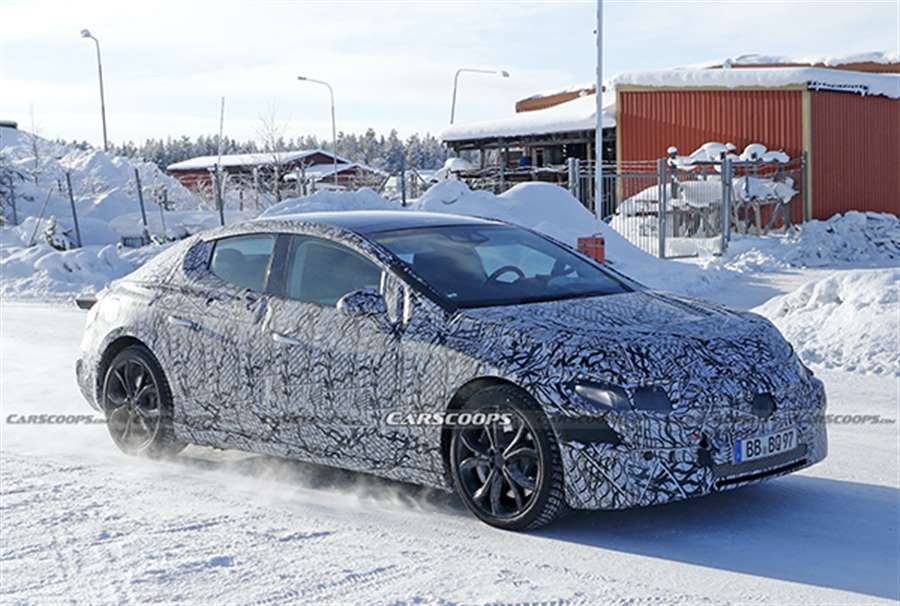
However, the EQE won’t just be a simple rework of the E-Class body shell. It will be based on the new Modular Electric Architecture (MEA) and feature a swoopy cab-forward design, as we’ve seen with the EQS, inspired by the Mercedes Vision EQS concept car.
Like the EQS Sedan, the EQE Sedan (codenamed V295) will spawn an SUV variation. In what could prove to be a confusing naming convention, this soft-roader be called the EQE SUV.
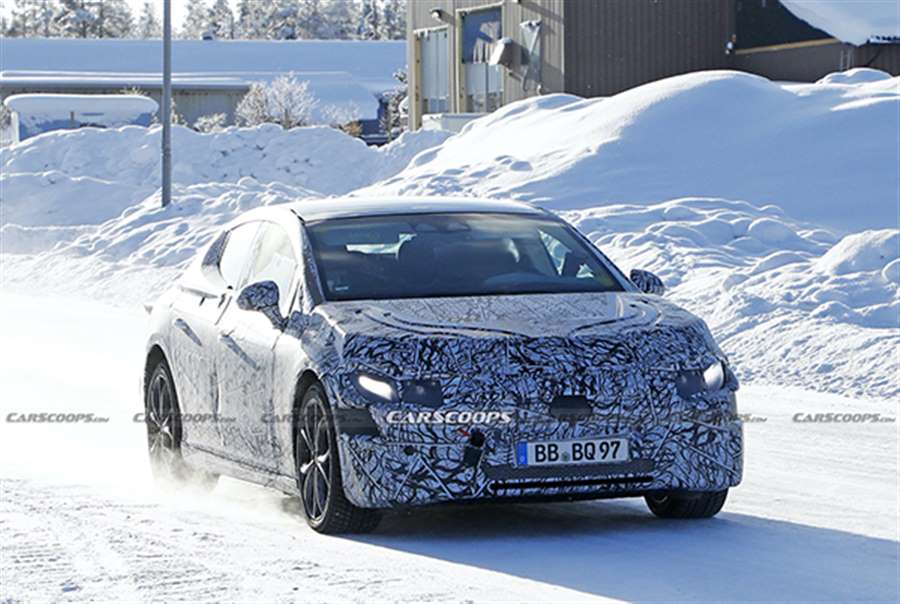
From these images, it’s evident that the EQE is smaller in overall diameter than the EQS Sedan, with our spy photographers noting that it may even be slightly shorter overall than the current E-Class. But, thanks to the EVA platform’s flat-floor design, the interior is likely to be more spacious than the ICE-power car.
The EQE also offers a “proper” boot, unlike the five-door lift-back style featured on the EQS. The side profile’s most striking feature is how the beltline sweeps up in a manner not often seen in a Mercedes-Benz design. That said, the heavy camouflage and body panel disguise would indicate that the outlines of the rear quarter panels and the hood are not to be believed just yet.
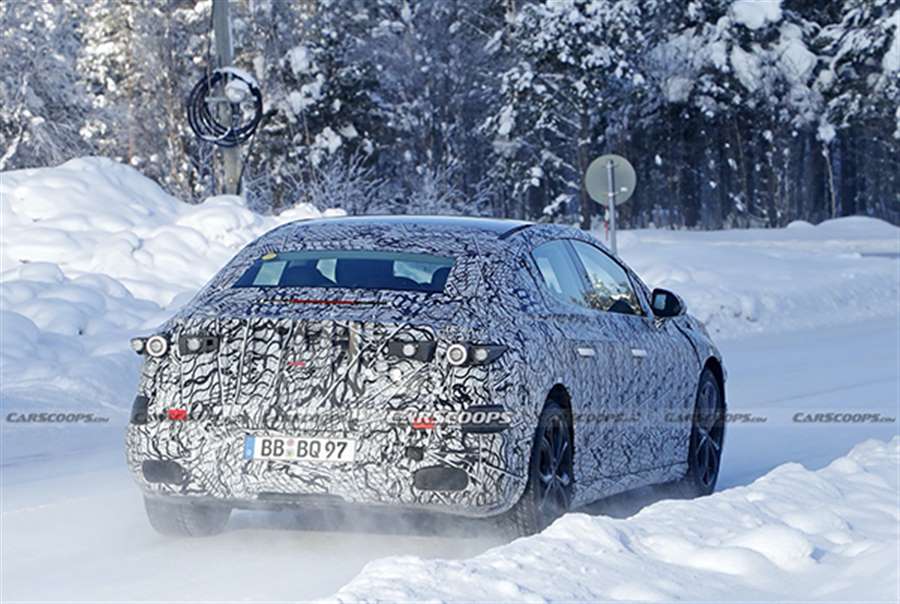
The interior is expected to feature a version of the forthcoming MBUX Hyperscreen. The boundary-breaking dashboard features three screens sitting under one massive expanse of glass. The glass stretches from door to door and allows the front-seat passenger to have their own dedicated display.
Powertrains are yet to be confirmed, as the car itself looks set to be a 2022 model. What we expect, though, are twin motor setups with all-wheel drive. The German carmaker aims to offer the bigger EQS Sedan with a driving range of up to 435 miles (700 km), so expect to see similarly impressive figures from the EQE as well.
There’s also a strong likelihood that we’ll see AMG models of the EQE Sedan as well, set to take on the likes of the Taycan, e-tron GT, and Tesla Model S. Read more > https://mercedes-world.com/eq/mercedes-benz-eqe-e-class
Mercedes is towing vehicles due to a fault in the emergency call system
More than 1.3 million Mercedes Benz vehicles will be withdrawn, because the emergency call system can send the wrong location after the accident due to a software error.
The car manufacturer made that decision after the accident that happened in Europe when the automatic system sent the wrong location of the vehicle.
During the investigation that began in October 2019, more similar cases were discovered, but according to the company's spokesperson, none in the United States.
Mercedes will withdraw a large number of vehicles from 2016 to 2021, including the CLA, GLA, GLE, GLS, SLC, A, GT, C, E, S, CLS, SL, B, GLB, GLC and G classes.
Daimler has announced that it will also withdraw the Metris 2016-2020 and Sprinter 2019-2020 cars.
Mercedes-Benz announced that it will inform the affected owners and update the software systems free of charge.
The withdrawal of the car is expected to begin on April 6.
2021 Mercedes-Benz E 450 Coupe Review Test Drive
The schedule said a 2021 Mercedes-Benz E 450 was going to be showing up on Tuesday. The following week was therefore going to be a good one, at least automotively, with one of the finest sedans in creation gracing the driveway. Perhaps we’d take a nice family drive somewhere; take advantage of that big, comfy back seat.
Then the E arrived. It was missing doors. And B pillars. And that big, comfy back seat. This was in fact going to be a week spent with an E 450 Coupe. Admittedly, I had just assumed it would be a sedan and if I’m honest, I had pretty much forgotten the E-Class Coupe even existed. After all, two-door cars are increasingly an endangered species with scarce sales and a consequent meager selection of choices. To that point, the E 450 is the only car in its class. The coupes offered by BMW, Audi, Infiniti and Lexus are all smaller and cheaper, while there are a number of bigger and/or pricier choices.
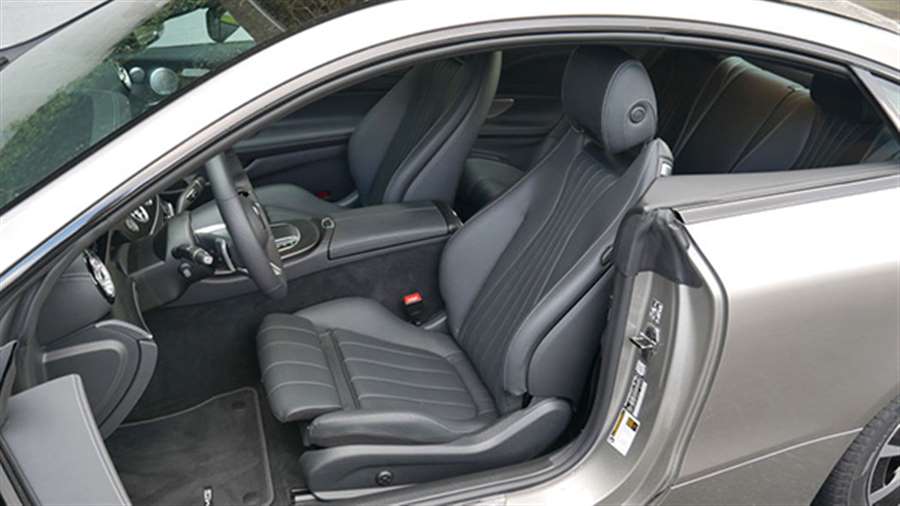
This scarcity is a tragedy. There’s an indelible romantic quality to coupes, especially ones as beautiful as this one, its curvaceous body slathered in silky Mojave Silver paint. They are indeed inherently less practical than a sedan or, ugh, a crossover coupe. They’re also inherently not a transportation appliance. By choosing a coupe, you’re far more likely to have drives that are more about the journey than the destination. Trips that are about the one or two people sitting up front, rather the kids or friends in back, and all the stuff you crammed into the trunk to enjoy away from the car at that destination. I can remember every coupe I took on a road trip: the Mercedes CL65 to the Grand Canyon, the Nissan GT-R to Vegas, the Challenger to Phoenix, the LC 500 to Bend, Oregon. All the sedans and SUVs everywhere else? They’re just a blur.
In a way, though, choosing a coupe is also the practical acknowledgment that back seats are often rarely used and trunks rarely filled. You can file a crossover coupe’s all-wheel drive and extra ground clearance into that folder as well. If you already have a practical car at home, why not indulge in a little automotive romanticism? When did we all get so sensible and boring?
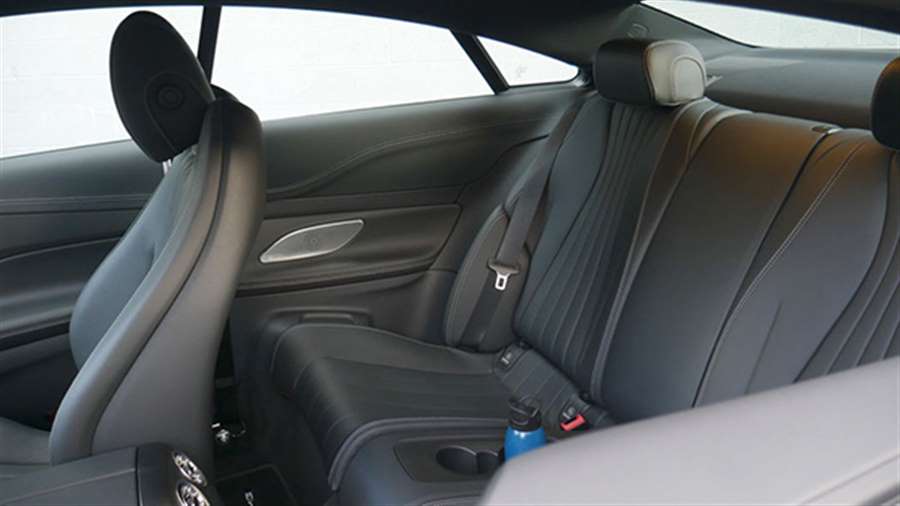
Probably around the time that traffic became unbearable everywhere and the vast majority of driving a chore. Why have a romantic car when so many people see nothing romantic in driving? We are not those people, though; certainly not if you find yourself routinely reading Autoblog. While much digital ink has been spilt in the crusade to #SaveTheManuals, some should be held in reserve to protect coupes from going extinct. Just as much would be lost.
Although the E 450 Coupe shares its interior design with its sedan and wagon siblings, the grand, opulent nature of it seems far more fitting in this most romantic of variations. The broad swath of open-pore wood seems to lap across the dash likes waves and cascades down the center console. The four rotary air vents stare out like the engines of a 747, their inner workings aglow in multi-color ambient lighting that complements the color glowing from behind the trim below. There are the grand, futuristic MBUX displays, the intricate Burmester speaker grilles and the novel, twin-spoke AMG steering wheel. This E-Class Coupe may not have been graced with one of the striking two-tone color combinations, but even in all-black, this cabin stands to make every drive that much more of an event, which, to belabor the point, is a coupe’s raison d’etre.
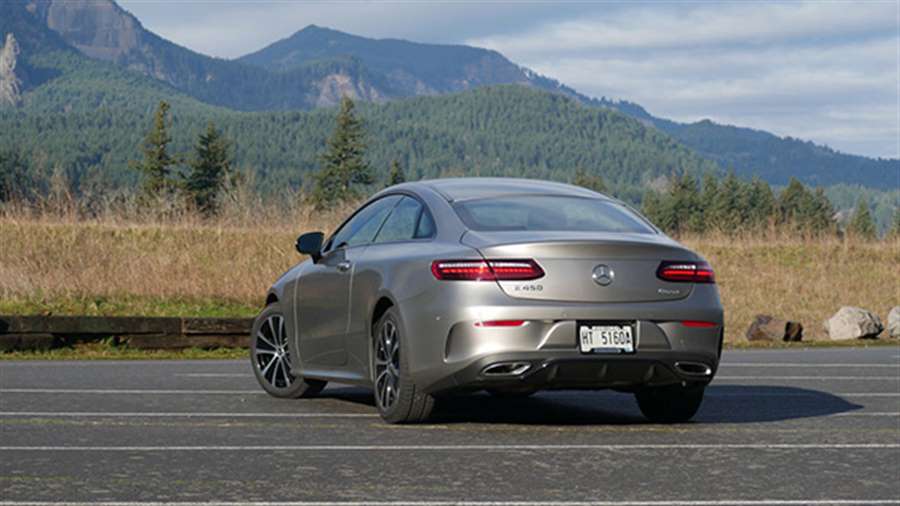
To that end, actually driving the E 450 is as special as one would hope. In true grand touring tradition, it can cosset you comfortably for countless miles with a ride that’s far cushier than anything you’ll find in a sports coupe (a BMW M4, for example). True, our test car benefited from ample sidewall courtesy of 18-inch wheels, significantly reducing the chances of harsh reactions to gnarled pavement. Yet in its pocket was also the optional Air Body Control air suspension, a cool $1,900 that’s very well spent. In addition to providing the aforementioned plush ride one might expect from something dubbed an “air suspension,” its ability to firm up the damping and lower the ride height also improves handling. While most cars today have some sort of drive modes that alter various components and controls to create a more relaxed, comfortable or engaging driving experience, the E 450’s goes a bit further by actually transforming the car’s character.
With the suspension considerably firmer, the steering tauter, the transmission staying in lower gears and the throttle more responsive to delicate inputs, you might as well be in a different car. That’s neat, because the car you were previously in was pretty great. So is this one, but in a different way. In Sport+, or to a lesser extent Sport, it suddenly feels smaller and more agile, as if shrink-wrapped around you. At the same time, the suspension never becomes intolerably firm, nor the powertrain overcaffeinated. It doesn’t try to be a sports coupe and is better for it.
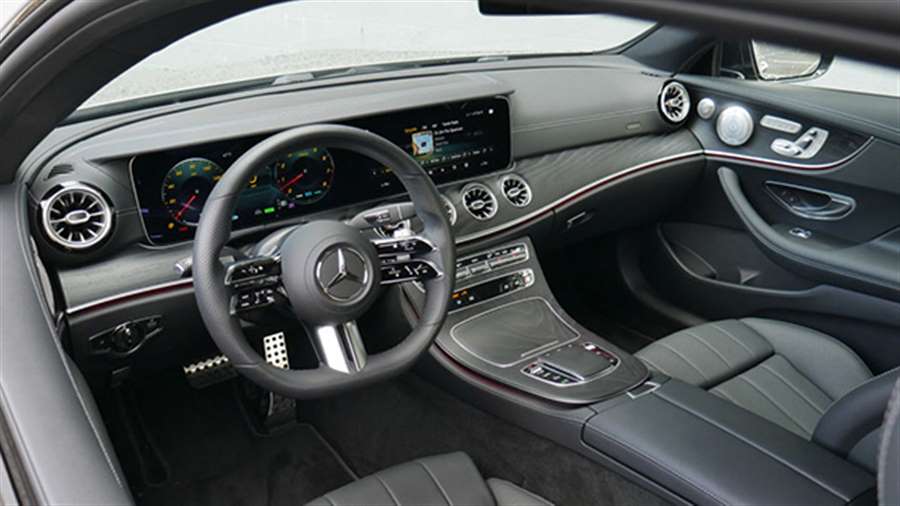
Under hood, the E 450 has Mercedes’ innovative new turbocharged 3.0-liter inline-six with EQ Boost mild-hybrid system. It’s good for 362 horsepower and 369 pound-feet of torque, and when paired with 4Matic all-wheel drive as this was, dispatches 0-60 mph in 4.9 seconds. True to the car’s character, this is a rather undramatic powertrain. There are no histrionic AMG exhaust noises, and if Mercedes pipes in anything fake through the sound system, it’s certainly not noticeable. It’s incredibly smooth and effortless in its power delivery, which probably shouldn’t be surprising for an inline-six amplified by a turbocharger and an electric motor. If there is a dynamic complaint, it’s that the nine-speed transmission’s Sport+ mode isn’t quite as eager to downshift when braking as in AMG applications.
One also has to acknowledge that by going with a traditional hardtop coupe design and dispensing with the B pillar, you can detect a slight loss in structural rigidity, especially over bumps. There’s no flex or creaking or anything overt, but there are also no free lunches. At least the resulting meal of freer-flowing air and the classic coolness of a hardtop is forever tasty. Pity about that little vestigial window bit at the rear.
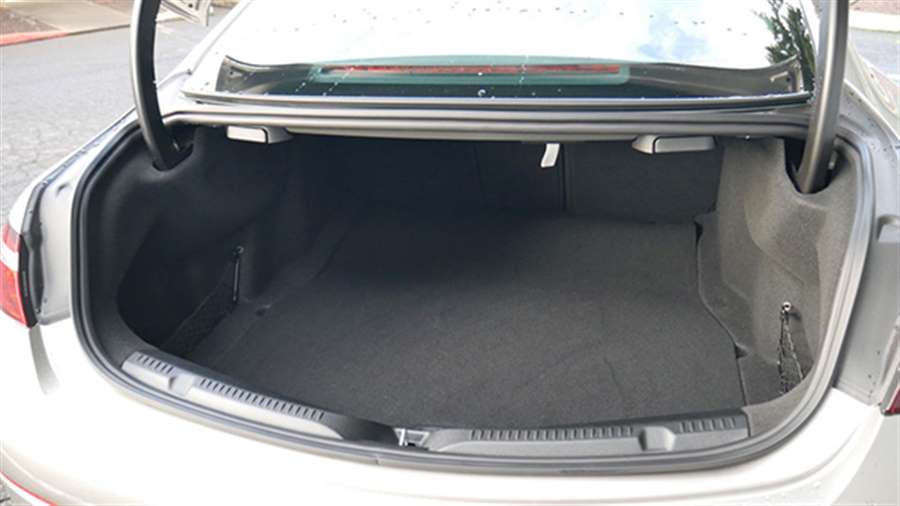
Losing the B pillar also makes it far easier to climb into the back seat, but this is still a coupe. It’s obviously a lot less practical than a four-door car. At least it’s a big coupe. The trunk measures a perfectly usable 10 cubic feet, and the back seat offers sufficient legroom for average-sized adults. Headroom is surprisingly good too, although taller folks may find the car’s rather aggressive tumblehome making contact with the side of their head. Weird.
Really, the E 450’s biggest drawback is one common with every newer Mercedes: the MBUX interface is convoluted and frustrating. Sure, it looks pretty, but it’s laborious to switch between menus; too many icons are small and the same color as the background; and although it utilizes a touchscreen, the unit is so far away, I end up wanting to use the touchpad that falls readily at hand. Except touchpads are a terrible way to control things in a car. See Lexus, Remote Touch.
Yet much like that infernal bit of tech in the otherwise exquisite Lexus LC 500, my dislike of MBUX doesn’t come close to ruining the Mercedes-Benz E 450 Coupe. It may represent a segment of one, but it’s hard to imagine any brand possibly topping this masterful and appropriately romantic effort. It’s a special car and it made for memorable drives, even if here in early 2021, there was nowhere to really go. I suppose that makes a car like this even more important – your drives have to be about the journey since the destination is inevitably bound to be something no more exotic than Target or the drive-thru.
Starting in 2024, Full Mercedes-Benz Lineup Will Have Autonomous Capabili
Newly announced partnership with Nvidia will include over-the-air upgrades and could even yield a Mercedes App Store.
- Mercedes-Benz and Nvidia have announced a new partnership that will bring upgradable AVs and, maybe, a Mercedes App Store.
- This new deal doesn't exactly replace Benz's previous deal with BMW, which was put on hold last week due to future model timing.
- Based on the Nvidia DRIVE platform, the new partnership will be used in every next-generation Mercedes-Benz vehicle starting in 2024.
When planning for the future, it doesn't hurt to give yourself some options. Last year, for example, Mercedes-Benz and BMW announced that they would work together on autonomous passenger cars that would be available to private customers starting in 2024. Last week, that cooperation effort was put on hold and then this week, Mercedes announced a new partnership with Nvidia on automated-driving technology to be trolled out in new Benzes starting in 2024.
Even though that could be read as Daimler swapping out BMW for Nvidia for its upcoming AV tech, the reality is a bit more complicated. A Mercedes-Benz spokesperson told Car and Driver that the cooperation with Nvidia is independent from the one that was planned with BMW. "The timing with planned models from BMW did not fit, that is why we put the cooperation on hold and may resume later," she said. "With Nvidia we are looking at a software-defined architecture for automated driving features. This is different to what was planned with BMW."
Different and bigger. Danny Shapiro, Nvidia's senior director of automotive, told C/D that the future that his company's new deal with Mercedes-Benz offers comes with support from the top, which means Nvidia CEO Jensen Huang and Mercedes-Benz AG CEO Ola Källenius.
"Don't think of [the announcement] as a product but a change in strategy and architecture that [Mercedes'] entire future lineup is based on," he said. "It's very significant on both sides. It's rare for an automaker to put so much trust in another company. Ola and Jensen have been working very, very closely on this. It's top down in both companies."
Every Mercedes Will Get Nvidia's AI Supercomputer
So, what's in the deal? As Shapiro said, a lot. Mercedes-Benz and Nvidia are going to build a new software-defined computing architecture for automated vehicles based on the Nvidia DRIVE platform that will be installed across the fleet of next-generation Mercedes-Benz vehicles, starting in 2024.
"It's really a transformative business model for Nvidia and Mercedes-Benz," Shapiro said. "The entire fleet, every car from the entry A-classes to the S-classes, will have the highest-performance Nvidia AI supercomputer on board."
Shapiro said that each of these new Mercedes vehicles will come with the full surround sensor suite installed and then, similar to how Tesla does things today, it will be up to owners to decide if they want to activate features, either when they purchase the car or after the fact with an over-the-air update. "There will be different business models, subscription service possibilities or one-time fees or things like that, depending on the region, that potentially turns the car into a fully upgradable, perpetually upgradable device, and there potentially could be be a Mercedes App Store," he said.
The features include what Mercedes calls "state-of-the-art automated driving functionalities" that will be able to "automate driving of regular routes from address to address," but since Mercedes is only promising Level 2 and 3 autonomous driving, the driver may need to take over in some situations during the drive. Mercedes says future automated parking functions that use this system could offer up to Level 4 capabilities, which means the car could go park on its own.
Source: caranddriver.com
Top 5: road cars signed by Cosworth
Often in the world of cars, a story is repeated that begins something like this: "When you and those characters started this or that year, they didn't even know that…".
Well, this story won't start like that, because the brilliant minds in front of Cosworth foresaw the future very well and knew even better what they were doing. And this thesis is shown by these road cars with their signatures.
So here is a brief cross-section of the best that this ingenious duo has offered for road use…
There is no doubt that Mike Costlin and Keith Duckworth have become immortal since 1958. There is also no doubt that the engines and other components of this ingenious duo have been revered by millions of Ford fans and beyond over the years. Because what Cosworth has achieved in the world of engine optimization, refinement, performance increase and construction of legendary race cars, practically no one has ever managed to achieve.
Having Ford, Mercedes-Benz, Audi, and even a Cosworth-signed Subaru in my possession has always been something special. And the owners of various Sierra, Escort and other other cars were rightly proud of their cars.
Because Cosworth, despite all its flaws (and there were some), has always fascinated with its ingenious solutions, crazy ideas and revolutionary machines that power some of the most respected cars of all time.
Both on the street and on the track.
True car enthusiasts, whose coexistence with cars does not come down to blind worship of one brand or worse, one model of one brand, know very well what this legendary company has signed from 1958 until today.
But some of you esteemed readers might be surprised with our selection as part of Cosworth’s list of the best road races.
So there is no choice but to start with this short and sweet list of really special road races with Cosworth's signature…
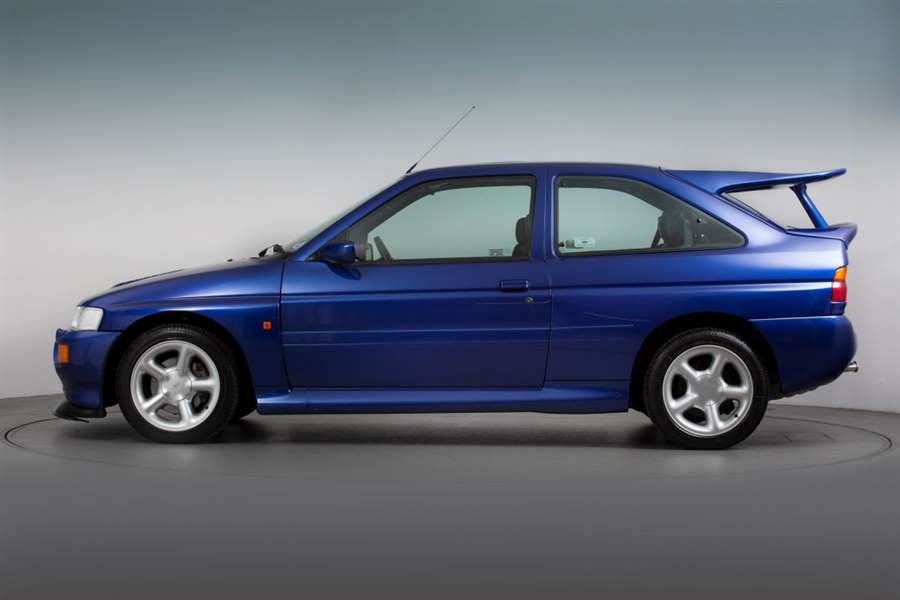
Number 5: Ford Escort RS Cosworth
"Cossie"… "Cossack"… "Escort on steroids"… Indeed, this car has certainly been called by car enthusiasts over the years.
But all these names, adjectives, suffixes and slang names have one common denominator. And that comes down to one of the most special angry compacts of all time.
For many, this car marked an entire era of racing on the dirty and dusty tracks of the World Rally Championship.
For many, the RS Cosworth was the "car" that made them indulge in the world of cars in their entirety.
Many also swear by the absolute superiority of this Escort compared to the competition from that wonderful time.
And maybe all those many are right, but Ford with this car in its road edition did not intend to break any records, nor was it expected that this icon from the nineties and a few decades later would be adored by a huge amount of people.
The idea was to accomplish the series needed to comply with the homologation rules and that’s usually it.
But despite this, the Escort RS Cosworth still stands on the pedestal of the most special cars of all time - although through some figures, the wickedly high price and often questionable durability may not deserve it.
The Cossie, with its body just like an ordinary Escort, looked like a neighborhood hooligan.
His character was like the once famous movie diva whose alcohol drank his brain and reflexes, while due to frequent breakdowns, this Ford fell out of the car, which caused its owners to go bald unplanned.
But the two-liter engine with its 227 horsepower and all-wheel drive was absolutely fascinating even with a Turbo-hole the size of a Marianas furrow.
And then there’s that ingenious and equally oversized spoiler on which laundry could be dried.
Basically, if there is an icon on four wheels in the world that can be recognized from any angle, then it is precisely the Escort RS Cosworth.
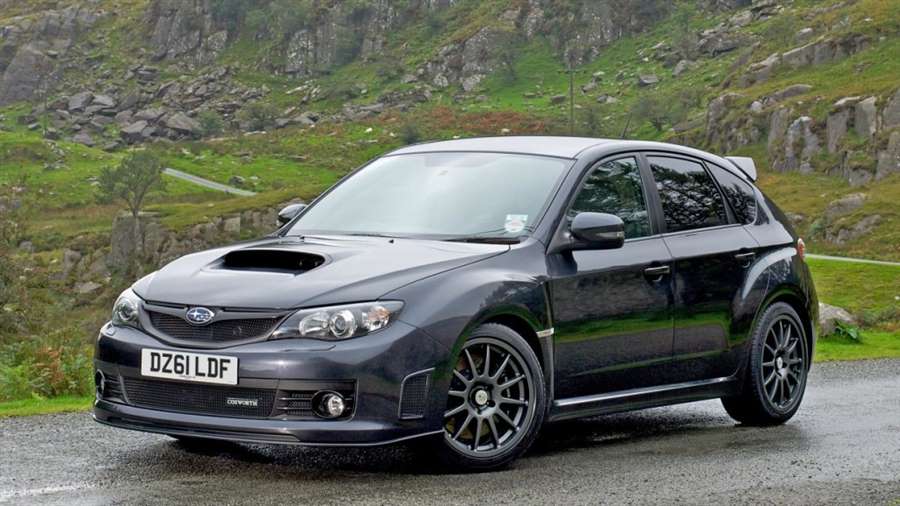
Number 4: Subaru Impreza WRX STi CS400
Yes… Cosworth had his fingers in this legendary Japanese car as well. And you may not have known it, but it still doesn’t negate that fact, because this car really did carry Cosworth’s signature.
The idea was simple: to produce something really special and thus at least partially try to annul all the negative reactions that Impreza GR was collecting even in its strongest version.
Because the Impreza has always been a sedan, while the third generation of this model is presented in the form of a compact with five doors.
And yes… This Impreza was as disgusting to watch as it was shocking to comprehend. Therefore, Subaru struggled in all possible and impossible ways with various variations on the special editions of this body version for the Impreza, before the definitive capitulation and the release of the sedan (GV) version on the market.
But before that happened, for many the ultimate Impreza of the time
the woman was created in collaboration with Cosworth.
Basically, the ugly compact still wore vulgar spoilers and a design signed by the correctional team from the subject "design and engineering". I guess that’s why the focus this time was definitely shifted under the hood under which Subaru’s heart was pounding with Cosworth’s pacemaker.
The four-cylinder, 2.5-liter engine at Cosworth is disassembled into "simple factors" and then rearranged from start to finish. And the resulting condition was shaped into an EJ257 engine with almost 400 horsepower.
With those 400 horsepower combined with a billion minor and minor minor revisions to the chassis, suspension, and powertrain and braking system, the Impreza WRX STi CS400 accelerated to 100 km / h in 3.7 seconds. That is, in translation more convincing than some five times more expensive super-cars of that time.
But despite this, this very interesting project was very quickly doomed. Because the price of £ 50,000 in the UK was simply exorbitant.
Either way, Cosworth has turned this Impreza from an ugly duckling into a dark object of desire for many.
And that’s actually quite enough to say as a conclusion about this car.
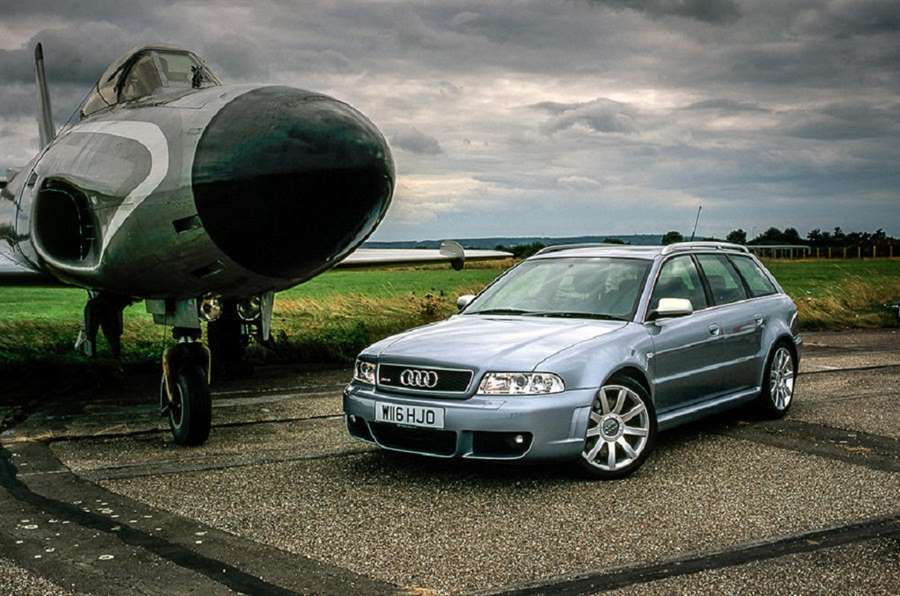
Number 3: Audi RS4 (B5)
Admit that you had no idea that Cosworth was also fiddling with this mobile box from Ingolstadt.
But admit it or not, history confirms that Audi without Cosworth would never have presented the successor to the legendary RS2 - at least not in the form in which we know it and with which we are fascinated.
Now… You must be wondering how this somewhat obscure collaboration actually came about.
So here is the answer to that question…
Namely, as Cosworth as a company was on the verge of bankruptcy in the late 1990s, at one point the idea was born to split the company into two parts. The newly formed divisions were oriented separately towards road cars and those with which the team raced along the track.
In those years, Audi persistently tried to create a successor to the legendary RS2, so instead of cooperating with Cosworth, it simply decided to buy the road division of that company and throw the employees into the fire. And look at the miracles - it turned out great.
Because on the one hand Cosworth did not put the key in the lock forever, while on the other hand Audi produced one of the most special models of all time. And a model with a coat of arms.
Many swear that the first RS4 is also the last real Audi with the correct pedigree and without unnecessary marketing nonsense. Because this caravan already looked serious with its appearance, while driving it was able to embarrass many times more expensive, nominally faster and much more famous super-sports cars on the planet - by driving kids to school and Labradors to the toilet.
The 2.7-liter V6 engine was already a respectable force on the road. And after Cosworth's interventions on the engine in question (especially on the pistons and the exhaust system) with its 380 horses, this really became one of those cars that made the "haters" of the caravan want to have one in the yard.
acceleration to 100 km / h took less than 4 seconds, while top speed was limited to the agreed 250 kilometers per hour in Germany.
So even though I guess megalomaniacs and number addicts will say the proverbial "meh" and wave their hands, the Audi RS4 still remains one of the most brutal family cars the world has ever seen.
And without Cosworth, all this would not be possible.
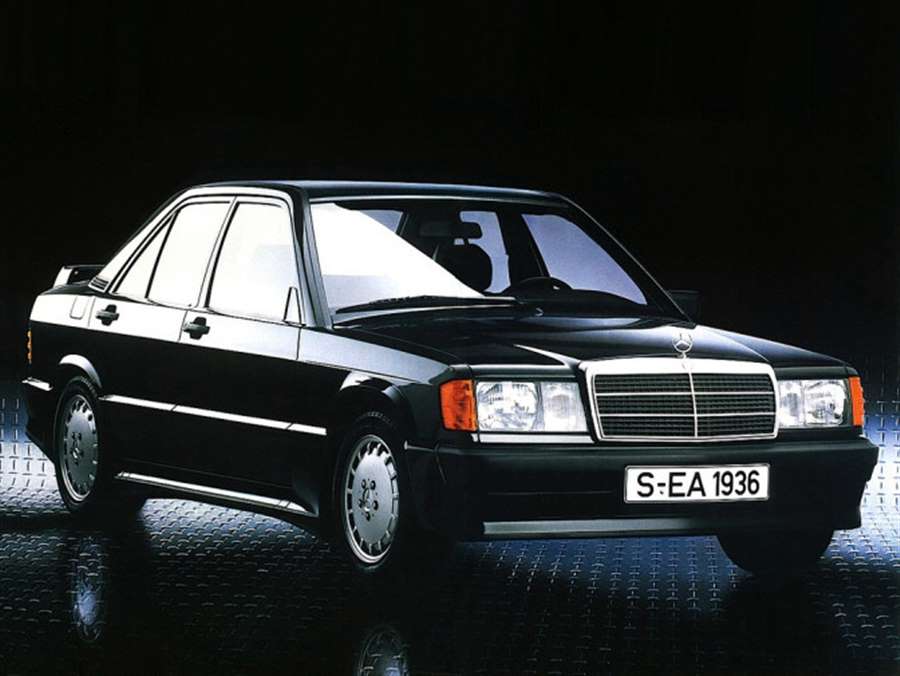
Number 2: Mercedes-Benz 190E 2.3-16
That by any chance AMG was an official part of Mercedes' three-spoke empire, and that in 1983 the company's employees had the time, will and desire, who knows what the story of this car would look like.
But as AMG was not part of Mercedes' three-legged empire at the time, and as the company's employees were on a cigarette-two break just then, Mercedes-Benz dared to start a partnership with Cosworth.
And the result state was shaped into one title title as part of the DTM competition from the early 1990s, and countless victories during the seasons that preceded that success.
But before that, this seemingly ridiculous fruit of collaboration between crazy Englishmen and anal-precise Germans also set several world records, including the one of 50,000 kilometers traveled in one piece and at a (combined) speed of almost 250 kilometers per hour. And without any malfunctions, without a general breakdown of the system and without any service interventions.
So, here is an example that confirms that Cosworth can really put his signature on something permanent and high quality, so the critics of this Mercedes derivative of the 190 and the collaboration with Cosworth were soon (and forever) gagged.
Mercedes-Benz 190 E 2.3-16 nowadays has a cult status. And deservedly so. Because from those times until today, it is not a common case for a company to present a car that is so close to the "ordinary" version, and at the same time stands fourteen light years away from it.
Because despite the fact that the 190 with its 185 horses and Cosworth's signature is not even the fastest limousine of its time, at the same time it clearly showed that it is one of the most special limousines of all time.
And by all accounts, it will remain so.
And rightly so.
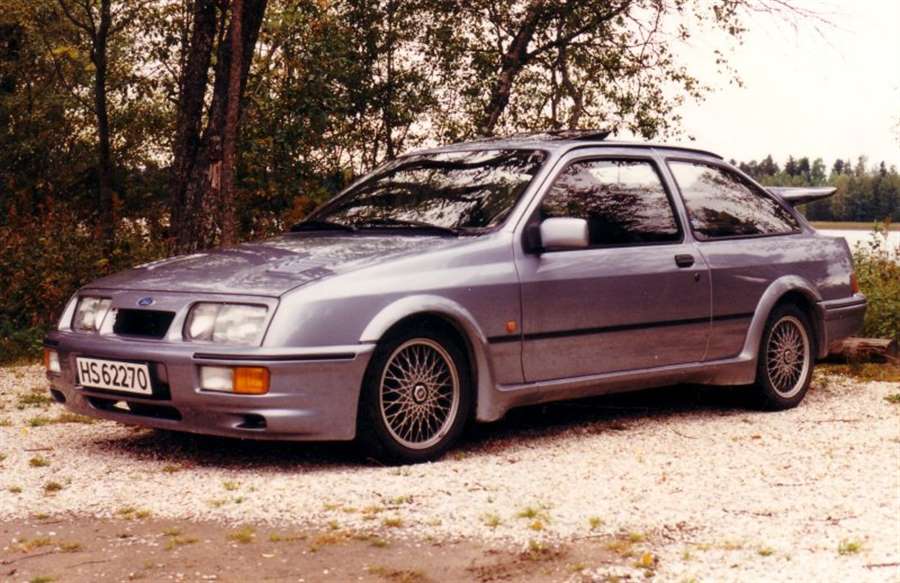
Number 1: Ford Sierra RS500 Cosworth
"As it was in the beginning, so it is now."
Because Sierra in this version with Cosworth’s signature literally kicked her ass wherever she appeared.
Europe has submitted to this Sierra several times and in several different domains of motorsport.
Australia too, and in the US and Japan this Sierra has earned an extremely high rating.
In a world of dust and dirt, Sierra has raised some of the best drivers of all time, of whom perhaps best to highlight is the legendary aggressor named Colin McRae.
The pedigree itself was present from some already past times in which Cosworth together with Ford played with several generations of Escort RS, so Sierra "only" continued that story. But the most special part of the "story" about the Sierra RS500 Cosworth was recorded on the street, ie among the "ordinary" people. Because it is in this segment that this car, despite a kind of handicap compared to competitors such as the BMW M3 (E30) and Audi UrQuattro, turned out to be a moral winner.
Namely, while Audi sold its UrQuattro in micron series and at the prices of preserved kidneys on the black market, and BMW moved the produced copies from garage to garage due to the lack of produced M-three models, Ford provided a larger production series for the Sierra RS Cosworth.
And with that, the Sierra took over the roads because of its accessibility, so it soon gained the status of a national hero in England. And that status holds to this day, when some of the preserved specimens at auctions record six-digit figures. And the version marked RS500 with its 500 produced copies only added that obligatory factor of exclusivity for this already loved and desired car.
The body extensions and the oversized rear spoiler from this uncompromising car certainly made a different beast than the ones moms, dads and taxi drivers rode on a daily basis. Although some still resent that the two-liter engine never got more than 227 horsepower, this is still the Sierra, which to this day is the alpha and omega for all those for whom the "fast Ford" is the ideal in the world of cars.
Ford produced a legend with this car, while Cosworth gave that legend a truly special beast with the character of an absolute savage. Ie. one of those cars that only the most capable behind the wheel could deal with in the right way.
And that’s why it’s the best road car Cosworth has ever put its signature on.
Do you agree?
Which car brands are most popular on the internet? What do we search for the most on Google
The Compare the Market website analyzed search data from 158 countries in 2018, 2019 and 2020
Toyota is not only the best-selling car brand in the world, the brand is also the leader in terms of search on Google. BMW, last year’s number one, dropped significantly in this year’s search.
The Compare the Market website analyzed search data from 158 countries in 2018, 2019 and 2020. The total number of car brand searches in 2020 was approximately 88 million. According to the study, Toyota ranked first in 55 countries, representing 34.8 percent of the total number of countries analyzed.
A year earlier, that position was still occupied by BMW, which experienced a huge drop in search volume during the year ravaged by the pandemic. A year earlier, BMW was the most sought-after car brand in 118 countries, compared to only 34 countries in 2020. That represents a drop of 64 percent.
Mercedes-Benz is in third place again this year. Interestingly, the Kia and Ford brands did relatively well, finishing in fourth and fifth place. Both car brands were in last place in 2019, and each was in first place in only one country.
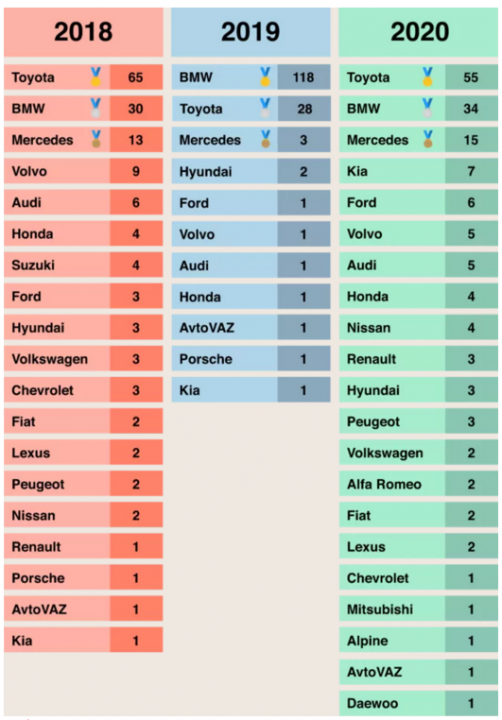
Mercedes-AMG G63 (2021) review: excess all areas
‘The old G-Class was a second or third car for most customers,’ Gunnar Guethenke (unsurprisingly nicknamed ‘Mr G’ as the head of Mercedes-Benz’s off-road division) told us back in 2018. ‘With the new model, we think it is a viable only car.’
That was a very big claim to make. Having tested one abroad and in the UK, though, we’re inclined to agree.
This G-Class represented the biggest shake-up in the model’s 40-odd-year history; the W463 model we all know and quietly admire had been on sale from 1990 until 2018. While there’s been little arguing about the streetside posing and rap-attack creds of the outgoing G, it drove, packaged and wobbled like a car knocking on the door of its 30th birthday party.
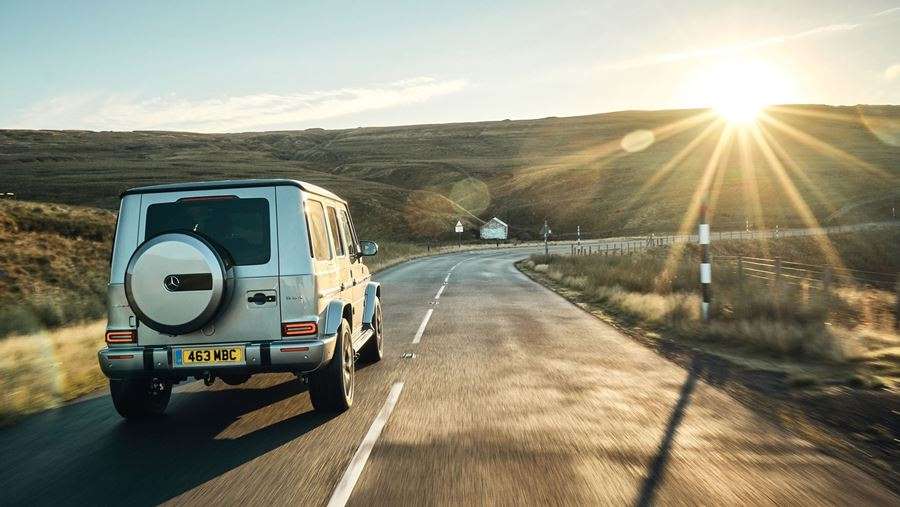
Here, we test the all-out AMG G63 variant.
What has changed with the latest G63?
Almost everything. Only three parts are carried over: the headlamp washers, the push-button door handles and the giant spare wheel cover bolted to the rear tailgate.
It’s still based around a sturdy (but new) ladder-frame chassis, built like steel girders to support a nearby suspension bridge more than a rich person’s plaything. Off it are hung steel and aluminium body panels, cleverly designed for maximum stiffness and a little less weight (mass falls by around 170kg, to a still-portly 2.5 tonnes).
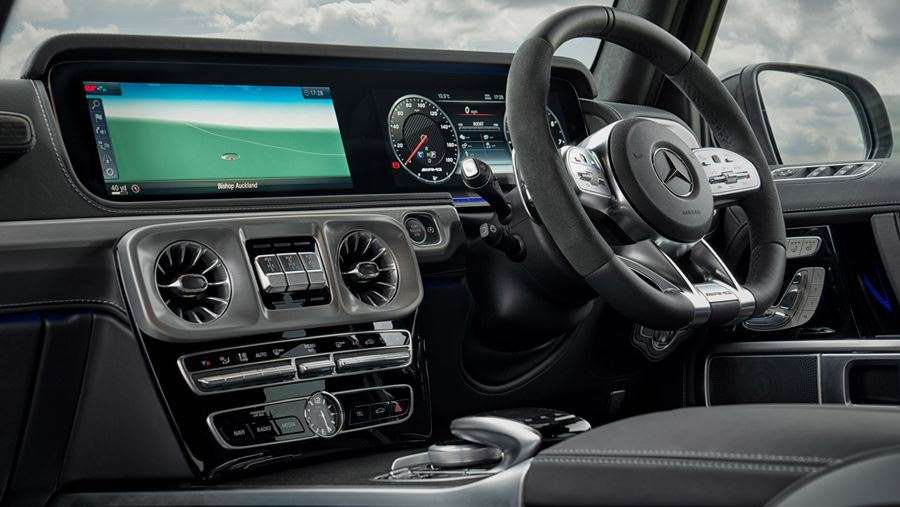
Much of that heft is attributed to the serious off-roading hardware; the new Mercedes-Benz G-Class range comes as standard with three fully locking differentials (one at each axle and a central clutch, to maintain traction in all conditions) and a low-speed transfer box. Daimler claims this provision is unique among off-roading brethren.
Climb aboard the new G and you won’t confuse old and new cabins. The old G-Class had a woefully cramped passenger compartment; your elbows felt pinched by the door cards, rear-seat passengers had nowhere to put their feet and the instruments and electrical architecture reflected the Betamax generation from which they hailed.
The new car is bigger, for starters: 53mm longer and 64mm wider, for superior packaging. It shows – even full-sized adults will be comfy in either row, and the rear bench can accommodate two, or even three, grown-ups thanks to thinner front seats and an impressively almost flat floor. The boot is an adequate 454 litres, pinched by the sub-woofer on the left and fuel tank on the right. Access it via the mother of all side-hinged, heavy tailgates which now locks into place at any extension so it won’t blow shut in a high wind.
Most striking of all is the E-class instrumentation that’s transformed the dashboard: giant twin 12.3in digital displays are standard in UK models (elsewhere you can order retro physical dials, should you fancy) and all the latest Merc trickery is present and correct. So you can now enjoy Apple CarPlay to sync your phone, skip around the menus using wheel-mounted thumb trackpads and there’s even a wifi hotspot. On a G-wagen!
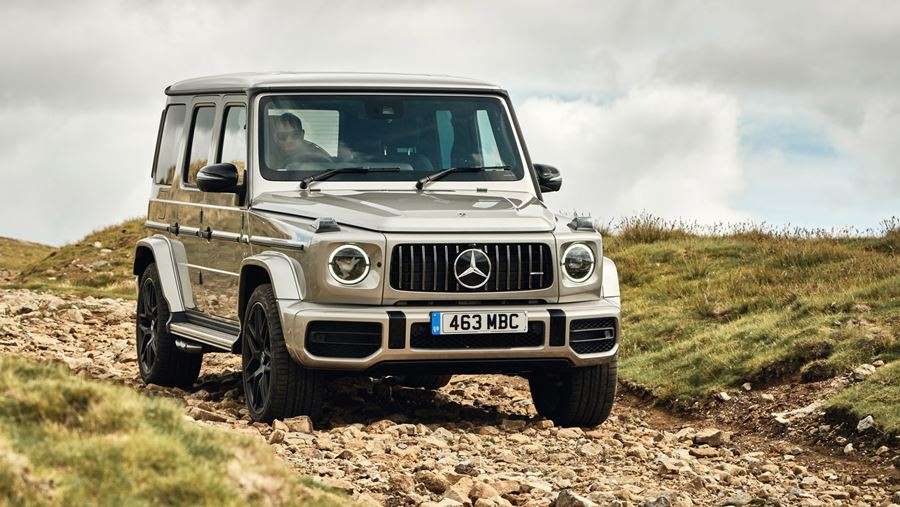
Oh, and there’s still a sturdy grab handle in front of the passenger, as a permanent reminder that this car is still all about scaling serious inclines more than the next playlist.
What’s the AMG G63 like to drive?
You quickly sense how thorough this overhaul is. The G might look incredibly similar from outside, all the way down to those faux rain gutters and sturdy exposed hinges that riff on the G aesthetic, but it’s essentially very modern.
This full-monty AMG G63 which brings the mother of all twin-turbo 4.0-litre V8s with a faintly ludicrous 569bhp and 627lb ft all the way from 2500-3500rpm. There’s also a G350d available in the UK, which we’ve ran as a long-termer.
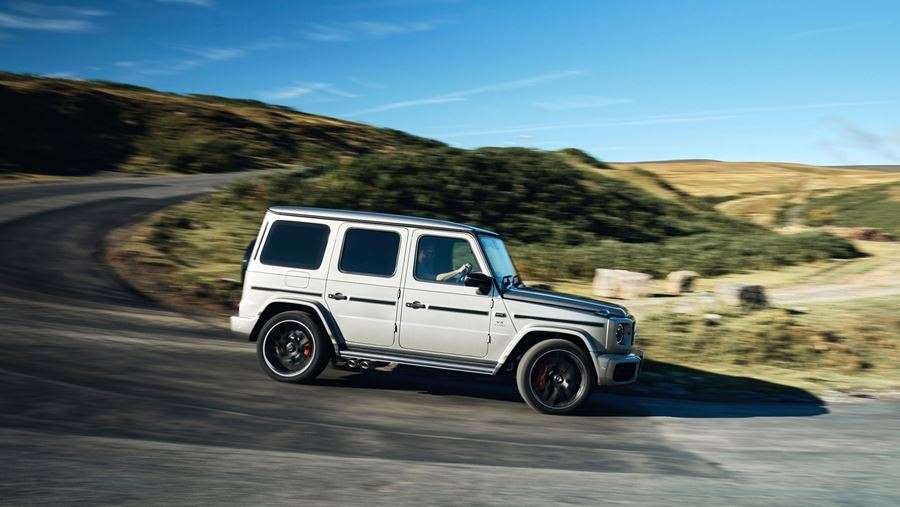
The AMG G63 So it’s neck-snappingly quick, with 0-62mph in a claimed 4.5sec and you can derestrict it up to 149mph if you’re feeling especially brave. Performance is accompanied by the rudest of V8 blare, exaggerated in Sport mode to bounce off walls and draw even more attention than the set-square boxy G-Class already musters.
The old one was fast, too, but felt like it was about to hurl you off the road at the first sign of a corner or bump. The new chassis delivers a quantum leap in ride and handling, soaking up the majority of road scars and – praise be! – delivering something approaching steering response and feel.
Thank the new electric rack and pinion steering, replacing the stick-in-porridge accuracy of the old recirculating ball set-up. Look: the new G-Class might be lighter but it’s still nearly 2.6 tonnes and you’ll never make that much metal truly agile, but the new G-Class has a damn good go at it. There’s still some hefty body roll – something you clearly have to expect from an enormous box that’s lifted several feet off the ground – but, again, it’s a marked improvement from the old one.
The chunky tyres (up to 22 inches in diameter, and down to 18s on Euro-spec models) give up the ghost first, squealing like a pig escaping the abbatoir, but body control and general poise are to be applauded. Driving the G-wagen is a lesson in upright boxiness, those perpendicular windows affording a fine view out – the bubble-wrap front indicators acting as a gun sight as you haul in the hot hatch hooligan up ahead.
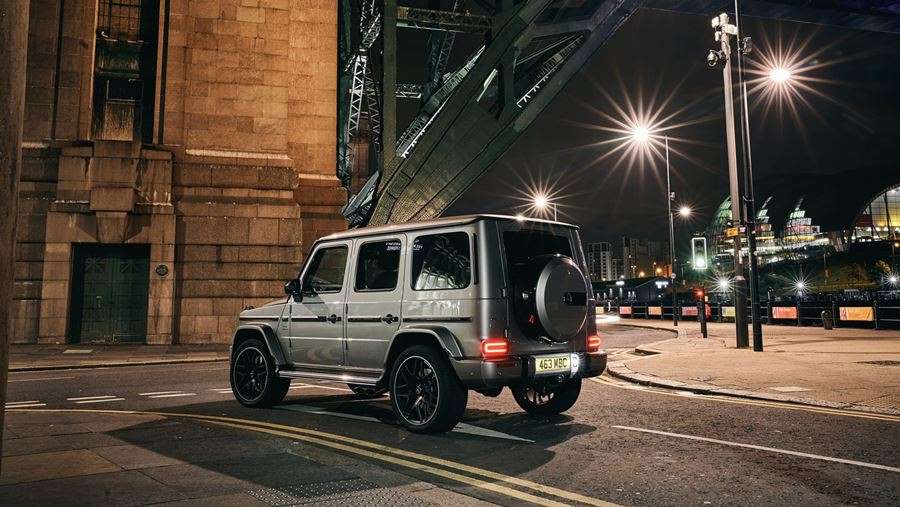
Will the new G-wagen off road like a Land Rover?
You bet. The G-Class has always been about genuine mud-plugging, as befits its ongoing military application among governments around the world. And the new one (still codenamed W463; it’s too iconic a badge to change, apparently) does more of the same.
Proper ground clearance (241mm), stubby ends for goat-like departure (30º), approach (31º) and breakover (26º) angles mean the new G-Class can scamper up the most extraordinary terrain.
The locking differentials help here, and you can adjust them on the fly at speeds of up to 30mph. You can feel each individual wheel grabbing at the ground and the low-speed transfer case means you can descend steep hills on tickover, as engine braking does its thing. It’s frankly incredible off-road – right up there with the best from Land Rover or Jeep.
Mercedes-AMG G63: verdict
There’s some truth to Guethenke’s claim that the new G is a jack-of-all-trades. It can be a viable only car – so long as you don’t mind the ostentation, the steep running costs and the image, which is part gangster-swagger, part military, part supercar slayer. It’s an extraordinarily versatile car and one gifted with that oft-forgotten automotive talent: character.
Source: carmagazine.co.uk
Mercedes-Benz EQA review
Mercedes-Benz's latest EV is smoothly predictable
The latest new addition to Mercedes-Benz's growing line-up of electric cars is the EQA, the EV version of the existing GLA SUV. Although it looks like the aformentioned family car with a blanked-out nose, there's a lot of new technology under the skin, which will be shared with future models in the firm's EQ model range.
It's exactly the sort of product that the carmakers are telling us that buyers want right now – an electric SUV. And they're all rushing to build them for us, with the EQA's rivals including the upcoming BMW iX3, Ford Mustang Mach-E and Audi Q3 e-tron as well as the Volvo XC40 Recharge, which is already on sale in the UK.
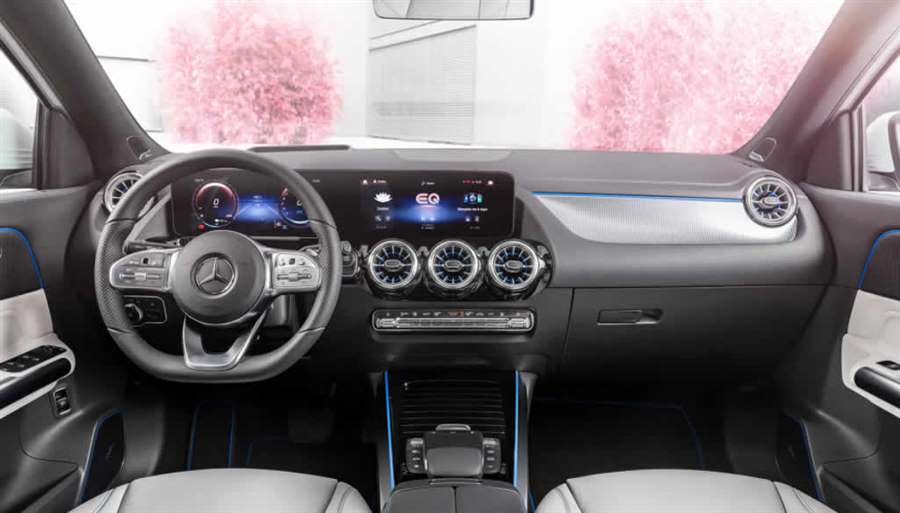
Design wise, it’s what you’ve come to expect from a small Mercedes-Benz SUV – smooth, creaseless design outside and an MBUX-equipped dashboard and infotainment system on the inside.
What's it like inside?
So it looks familiar inside, but there are some interesting touches, such as the instrument lighting which turns momentarily white when boost is active and the horizontally split performance meter which replaces the rev counter. There's also a fire red low-range warning scenario for the screen and the four driving modes are named Modern Classic, Sport, Progressive and Reduced.
The EQA can be had with the Energizing Comfort Plus package first launched in the CLS, which sounds like the answer to a question no one asked, but actually enhances comfort on long drives by offering massage functions, smartwatch connectivity, mood lighting, bespoke music and even a power nap feature you can use when parked up.
UK specs are yet to be confirmed, but trim levels in Europe include AMG Line, an Electric Art version with low-drag aerodynamic wheel covers and the launch Edition 1 featuring rose gold accents inside and out.
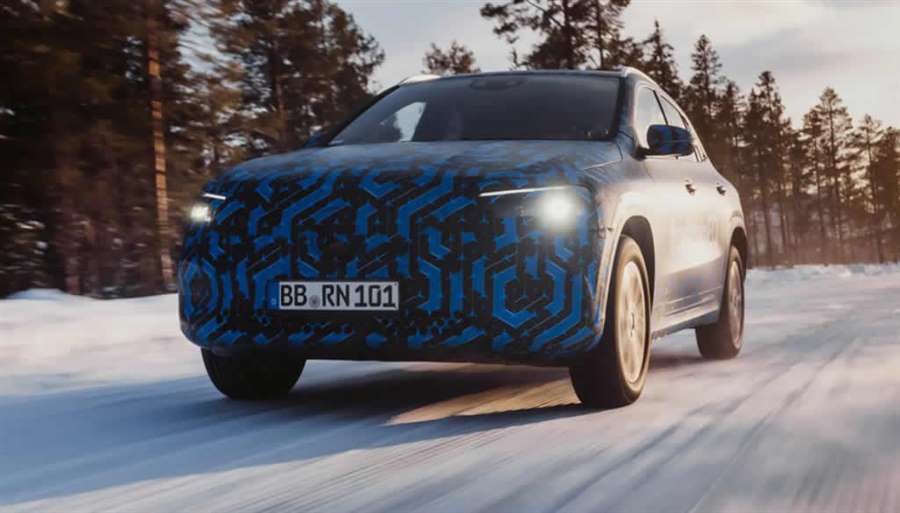
What's under the skin?
The good news is that there's some genuinely innovative technology under the skin and the claimed battery range and performance are impressive. A substantial lithium-ion battery pack is fixed into the floor, with the first model – EQA 250 – having a usable battery capacity of 66.5kWh. That lags behind the 78kWh you get in a Volvo XC40 Recharge, but is on the money for an EV of this size and class.
It's calibrated for range and efficiency rather than performance. The EQA 250 model claims up to 266 miles of range, according to WLTP figures, has a 0-62mph time of 8.9 seconds and a maximum speed of 99mph. You can charge it up to 11kW on AC at home, or up to 100kW on DC rapid charge.
There will be more EQAs to choose from, with Mercedes-Benz confirming that the EQA 250 model will be fjoined by power variants, including those with all-wheel drive. There will also be a 200kW (272hp) version later on (most likely badged EQA 300), and another variant that can claim up to 310 miles.
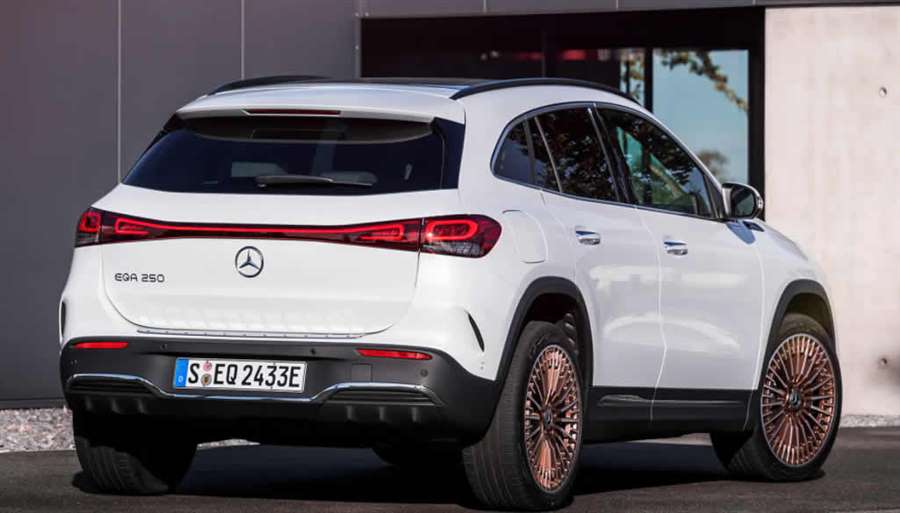
The EQA also gains the EQC's Eco Assist system, which uses navigation and traffic sign data to gauge how much brake regeneration is required at a given moment, and the navigation also takes into account charging times to give you as accurate a time as possible to get to your destination.
What's it like to drive?
We've had a quick drive of a pre-production EQA in prototype form, and can confirm that it's an impressively refined place in which to spend time. The main audio source up to 20mph is the pedestrian warning chime which, later turns into a subdued hum. Only when driving really hard does that murmur swells to a discreet growl.
Despite the modest claimed acceleration figures, keen drivers will enjoy way the EQA can cover ground with surprising vigour. And like all EVs, this seamless acceleration is uninterrupted by gearchange upshifts. The almost noiseless flow means you have little sensation of speed, which might be worth noting if you're not someone who watches the speedo like a hawk. Overall, it’s a refined machine, complete with a comfortable and cosseting ride.
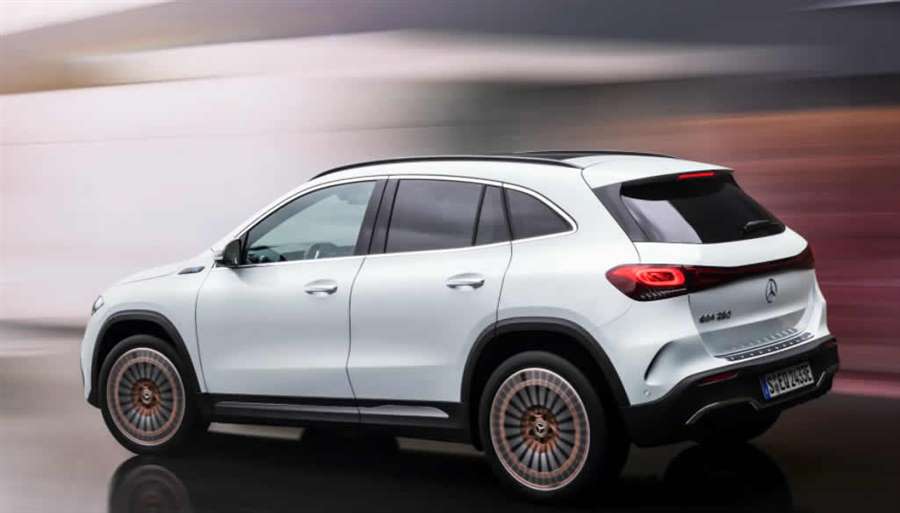
There are three recuperation modes (how much energy is recovered when lifting off the throttle) with different levels of energy regeneration labelled mild, medium and strong. Strong in particular feels like a viable one-pedal driving experience – lift-off and the car quickly loses momentum.
When will it go on sale in the UK?
Expect to see the EQA go on sale in the summer of 2021, with UK prices and specs yet to be confirmed. German prices start at €47,540, which suggest it'll be much more affordable than the XC40 Recharge and BMW iX3. There will be more related models to follow, with the EQB seven-seater SUV and EQS luxury saloon following later in 2021.
Source: parkers.co.uk

